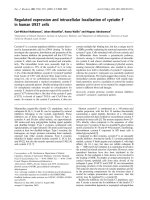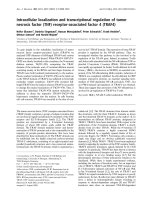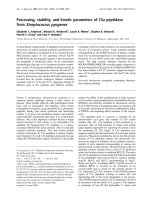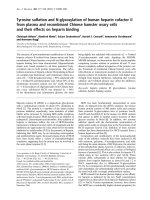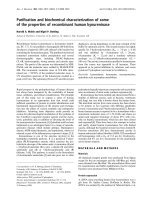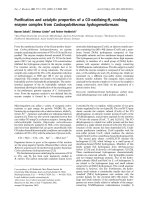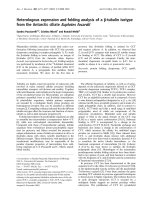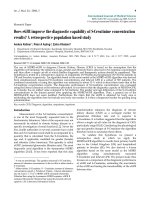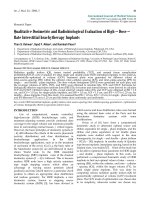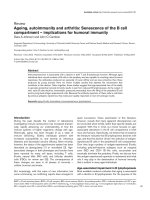Báo cáo y học: "Irritable mood and the Diagnostic and Statistical Manual of Mental Disorders" pdf
Bạn đang xem bản rút gọn của tài liệu. Xem và tải ngay bản đầy đủ của tài liệu tại đây (216.83 KB, 4 trang )
BioMed Central
Page 1 of 4
(page number not for citation purposes)
Child and Adolescent Psychiatry and
Mental Health
Open Access
Commentary
Irritable mood and the Diagnostic and Statistical Manual of Mental
Disorders
Daniel J Safer
Address: Departments of Psychiatry and Pediatrics, Johns Hopkins University School of Medicine, Baltimore, Maryland USA
Email: Daniel J Safer -
Abstract
Background: The terms 'irritable mood' and 'irritability' have been applied to describe and define
a variety of different categories in the Diagnostic and Statistical Manual of Mental Disorders (DSM).
More precise diagnostic terms and concepts are needed.
Methods: A concise critical historical review of DSM categories characterized by irritability, anger,
and aggression is presented followed by recommendations.
Results: This analysis describes the broad ranging and imprecise use of the term irritability since
the first DSM in 1952. A more age-appropriate and functional realignment of psychiatric categories
linked to dysfunctional anger is suggested. Among other recommendations, this realignment would
remove irritability as a problematic definer in the present DSM mood categories: expand
oppositional defiant disorder to include adults; link the callous unemotional subtype of conduct
disorder in adolescents to antisocial personality disorder; move intermittent explosive disorder to
an appropriate category: and expand the term 'mood' to apply also to dysfunctional anger and
anxiety.
Conclusion: The non-specific term 'irritability' commonly used in the DSM has had an adverse
effect on diagnostic specificity and thereby on treatment. Dysfunctional anger is a major mood
disorder which merits a more prominent and better defined representation in psychiatric
nomenclature.
Introduction
Irritable mood, defined in the Diagnostic and Statistical
Manual of Mental Disorders (DSM) [[1]
p.825
] as "easily
annoyed and provoked to anger," and irritability have
been part of numerous DSM diagnoses since 1952. After a
presentation of diagnostic background material and rele-
vant diagnostic terms, recommendations will be made to
more precisely categorize disorders related to dysfunc-
tional anger.
Background on Irritable Mood in the DSM
1) Irritable mood has been a defining DSM characteristic
of manic episodes since 1952
Irritable mood became a major defining characteristic of
manic episodes beginning in 1952 with the first DSM
[2]
p.25]
as evidenced by the following sentence describing
a manic-depressive reaction, manic type: "This group is
characterized by elation or irritability and over- talkative-
ness, flight of ideas and increased motor activity". In
DSM-III [[3]
p.208
], a manic episode required "one or more
distinct periods with a predominantly elevated, expansive
Published: 24 October 2009
Child and Adolescent Psychiatry and Mental Health 2009, 3:35 doi:10.1186/1753-2000-3-35
Received: 13 October 2009
Accepted: 24 October 2009
This article is available from: />© 2009 Safer; licensee BioMed Central Ltd.
This is an Open Access article distributed under the terms of the Creative Commons Attribution License ( />),
which permits unrestricted use, distribution, and reproduction in any medium, provided the original work is properly cited.
Child and Adolescent Psychiatry and Mental Health 2009, 3:35 />Page 2 of 4
(page number not for citation purposes)
or irritable mood," a definition which is nearly identical
in subsequent DSM revisions [[4]
p.217
, 5
p.328
]. Thus, irri-
table mood by itself can substitute for elated or expansive
mood as the diagnostic basis for a manic or hypomanic
episode.
2) Irritable mood is restricted to the Mood Disorders
category of the DSM
Mood disorders in the DSM-IV include only depressive
and bipolar disorders. Three different moods define these
diagnoses. They are depressive, expansive/elevated, and
irritable moods. Elevated/expansive mood defines manic
episodes, as can irritable mood. Depressed mood exclu-
sively defines depressive disorders, except that in youth an
irritable mood can substitute for a depressed mood to
define major depressive episodes and dysthymic disorders
[1]. In the DSM of course, to establish a diagnosis of a
mood disorder beyond the presence of a defined mood, a
duration criterion must be reached and a specific number
of symptom descriptors are required. Pathological anxiety
and anger are not considered to be mood disorders in the
DSM, although they are listed as abnormal moods in a
majority of psychiatric texts and dictionaries [6-8]
3) Irritability is a common symptom descriptor in many
DSM categories
Irritability is listed as a descriptor of numerous and varied
disorders in the DSM-IV. These include Generalized Anxi-
ety Disorder, Post Traumatic Stress Disorder, Borderline
Personality Disorder, Antisocial Personality Disorder,
Nicotine Withdrawal, Pathological Gambling, and
Schizoaffective Disorder [1,9,10]. Although irritability is
not a specific descriptor in Oppositional Defiant Disor-
der, its importance in that disorder can be inferred from
descriptors such as "often loses temper" and "easily
annoyed by others". Irritability is also not included as a
DSM descriptor for depressive disorders, but in reports of
presenting symptoms by depressed adults, it is recorded in
the majority of cases [11-13]. Similar rates of irritability
(73%) were reported by adults with bipolar disorder
when entering the large STEP-BD trial [14].
4) Aggressive behavior defines numerous personality and
behavior disorder diagnoses in the DSM
In the DSM, frequent episodes of rage and aggression have
defined a number of personality and problematic behav-
ior disorders. In the first DSM [[2]
p.37
], aggression was
identified as passive-aggressive personality, aggressive
type. In DSM II [[15]
p.42
] explosive personality disorder
was characterized by "gross outbursts of rage or verbal or
physical aggressions". In DSM III, IIIR and IV, intermittent
explosive disorder was characterized as aggression
" grossly out of proportion to any precipitating psycho-
social stressors " that result in serious assaultive acts or
destruction of property [[5]
p.609
]. Antisocial personality
disorder diagnostic descriptors in DSM IV [[5]
p.650
]
included: " aggressiveness, as indicated by repeated
physical fights or assaults" and "reckless disregard for the
safety of self or others". For youth, conduct disorder was
characterized by destruction of property, aggression to
people and animals, and theft [[5]
p.90
]. As indicated,
aggressive behavior not irritability defines these DSM
disorders.
5). Terms like emotion, mood and trait are seldom clearly
applied in psychiatric practice
An emotion is an aroused mental state accompanied by an
autonomic manifestation that usually lasts minutes or
hours and is triggered by events. A mood is a pervasive
emotion lasting days and occasionally weeks and may
occur without an obvious trigger. A trait is present for
months or years and represents a discrete personality pat-
tern [16,17]. Irritability is a physiological emotional
response to a provoking stimulus; it may be recurrent but
it is usually short lived. Anger is a cognitive reaction to an
aversive circumstance, ranging from displeasure to rage; it
may or may not be dysfunctional. Aggression is a behav-
ioral or motoric response associated in psychiatry with an
intent to do harm; it may be self-directed. Hostility is a
directed, maintained attitude of ill-will [18-20].
Problems with Irritability in the DSM
A. Depression
1) Irritable mood was ill-conceived as a DSM diagnostic
definer of dysthymia and major depressive disorder
(MDD) in youth. Irritability is a fairly common feature in
youth diagnosed with MDD, 38% 55% [21,22], and out-
come studies bear out a strong relationship between irri-
tability in youth and depression in young adulthood
[23,24]. But unlike sadness and anhedonia, irritability is
not a core feature of depressed mood [19,25,26].
2) Irritability is at least as common in depressed adults
[11-13] as in depressed youth. In the large STAR*D natu-
ralistic clinical trial, 81% of the adults with MDD entering
the trial reported irritability, and half of this group
reported that this symptom occurred more than half of
their waking hours [13]. Nonetheless, even though irrita-
bility is very frequently reported by adults with depres-
sion, it is not listed in the DSM as a definer or a descriptor
for MDD in adulthood. This indicates a perplexing age-
group inconsistency in the DSM for the inclusion of irrita-
bility to characterize depression.
3) Irritability has been frequently used as a primary diag-
nostic feature to separate bipolar from unipolar depres-
sion [27,28]. It is indeed the case that those experiencing
both MDD and irritability in group data have more
impairment, a somewhat different family history and an
increased vulnerability to stress [13]. But one needs to
Child and Adolescent Psychiatry and Mental Health 2009, 3:35 />Page 3 of 4
(page number not for citation purposes)
consider that irritability is often an associated feature of
numerous other chronic psychiatric conditions (e.g,
ADHD, mental retardation, Alzheimer's disease) -and it
usually adds to a patient's risk of untoward consequences.
Thus, it is unclear at present if a depression with irritable
mood -by itself meaningfully constitutes a distinct diag-
nostic entity.
B. Anger
1) Irritability, anger, defiance and temper are specific
descriptors of oppositional defiant disorder (ODD) in
youth. ODD is operationally distinct from conduct disor-
der which is characterized by behaviorally aggressive acts.
In adults, diagnoses of dysfunctional anger are not as
clearly delineated. Antisocial behavior disorder in the
DSM is included as a personality disorder and its diagno-
sis focuses on violations of the rights of others [1]; it
closely matches an increasingly researched subgroup of
conduct disordered adolescents identified as callous une-
motional [29]. Intermittent explosive disorder (IED) is
characterized by impulsive aggressive and assaultive
behaviors out of proportion to stressors. IED is grouped in
the DSM under Disorders of Impulse Control, Not Else-
where Classified and combined in that category with klep-
tomania, trichotillomania (beginning in 1987),
pathological gambling and pyromania, disorders that are
more compulsive than impulsive [30]. In adults there is
no category akin to ODD in youth; essentially, there is no
category for adults who are frequently dysfunctionally
angry but not physically assaultive or repeatedly destruc-
tive.
2) Dysfunctional anger is one of the three most frequently
cited pathological emotions, the others being profound
sadness and anxiety/fear [31]. Anger, however, is not
listed in the index of the DSM IV-TR [1]. Furthermore,
anger, irritability, rage and irritable mood were not
defined by the American Psychiatric Glossary in 1980,
1988, 1994 and 2003 [32], and dysfunctional anger is not
listed in the DSM as a possible consequence of alcohol
intoxication [1,20] a not uncommon development [33].
3) Fortunately, psychiatric diagnoses in the National
Comorbidity Survey Replication (NCS-R) based on com-
munity interview data were newly grouped into 4 major cat-
egories; anxiety, mood, impulse control, and substance
abuse disorders (34). Included in the impulse control dis-
order group were: attention deficit hyperactivity disorder,
opposition defiant disorder, conduct disorder, and inter-
mittent explosive disorder. In the NCS-R analyses,
impulse control disorders had a 24.8% lifetime preva-
lence in adults and a 20% twelve-month prevalence in
adolescents both second only to anxiety disorders
[34,35]. Thus, disorders largely associated with dysfunc-
tional anger are not at all uncommon in the population
even though they don't merit a high profile in the DSM.
C. Mania
1) Although irritable mood in the DSM is one of the
defining features of manic episodes, it is not specific for
mania. Manic mood at its extreme is commonly character-
ized by frenzied, ungovernable exuberance essentially
elation not grounded in reality [8,36]. Acute manic epi-
sodes generally include multiple symptom dimensions
characterized by accelerated speech shifting in context,
increased motor activity, an expansive/elated commonly
delusional outlook, decreased sleep, and often also by
grandiose ideation, paranoia, dysphoria, distractibility,
and irritability/anger [8]. In factor analyses, anger/aggres-
siveness during a manic episode has been found to be a
separate dimension from elation; it is most closely linked
to paranoia [37,38]. Irritability and anger are seldom ini-
tial symptoms of this disorder; they generally develop
later in course of a manic episode [36,39,40].
2) It is quite possible to meet the DSM criteria for a manic
or hypomanic episode by having a recurrent pattern of
irritable mood with 4 of the 7 symptom descriptors of the
disorder. These descriptors could be: more talkative than
usual, distractible, decreased need for sleep, subjective
racing thoughts, and psychomotor agitation [1]. If four
such symptom criteria along with recurrent irritability are
identified during a psychiatric interview, this could par-
tially explain how 27%-34% of U.S. psychiatric inpatient
youth received a primary discharge diagnosis of bipolar
disorder in 2004 [41].
Concluding Comments and Suggestions
Biological correlates of dysfunctional anger disorders,
such as a higher androgen level, a low heart rate, and a low
level of the primary CSF serotonin metabolite [42], may
better define this area of diagnostic nomenclature in the
future. In the meantime, the following suggestions to
improve diagnostic precision in the DSM appear achieva-
ble.
The next revision of the DSM could benefit by: 1) extend-
ing ODD to include adults with irritability and dysfunc-
tional anger since an arbitrary age cut-off doesn't fit NCS-
R data 2) removing irritability as a definer for depressive
disorders in youth, but considering it as a possible
descriptor in all age groups. 3) removing irritability as a
definer for manic episodes, since it isn't a central feature of
manic mood. 4) including dysfunctional anger in the
DSM as one consequence of alcohol and hallucinogenic
abuse, since this is a very common occurrence 5) remov-
ing IED from Impulse Control Disorders, Not Elsewhere
Classified and including it within an appropriate category,
like a new dysfunctional social behavior disorder category
Child and Adolescent Psychiatry and Mental Health 2009, 3:35 />Page 4 of 4
(page number not for citation purposes)
6) limiting the frequently used but non-specific term 'irri-
tability' in the DSM, and when appropriate describing
the problem as dysfunctional anger 7) expanding the term
mood to apply to dysfunctional anger and anxiety as well
as to depression and mania, and 8) forming an age-related
continuum between conduct disorder callous unemo-
tional subtype in adolescence and antisocial personality
disorder in adulthood.
Competing interests
The author declares that they have no competing interests.
Acknowledgements
The article processing charge for this commentary has been funded by the
Deutsche Forschungsgemeinschaft (DFG)
References
1. American Psychiatric Association: Diagnostic and Statistical Manual of
Mental Disorders, Text-Revision 4th edition. Washington DC: American
Psychiatric Press; 2000.
2. American Psychiatric Association: Diagnostic and Statistical Manual of
Mental Disorders Washington DC: American Psychiatric Association
Mental Health Service; 1952.
3. American Psychiatric Association: Diagnostic and Statistical Manual of
Mental Disoders 3rd edition. Washington DC: American Psychiatric
Association; 1980.
4. American Psychiatric Association: Diagnostic and Statistical Manual of
Mental Disorders 3rd edition. Washington DC: American Psychiatric
Association; 1987.
5. American Psychiatric Association: Diagnostic and Statistical Manual of
Mental Disorders 4th edition. Washington DC: American Psychiatric
Association; 1994.
6. Tasman A, Kay T, Lieberman JA: Psychiatry 2nd edition. Chichester
UK, Wiley; 2003.
7. Steadman's Medical Dictionary 28th edition. Philadelphia: Lippincott
Williams & Wilkins; 2006.
8. Sadock BJ, Sadock VA: Kaplan and Sadock's Comprehensive Textbook of
Psychiatry 10th edition. Philadelphia,: Lippincott Williams & Wilkins;
2007.
9. Preskorn H, Baker B: The overlap of DSM-IV syndromes:
potential implications for the practice of poly- psychophar-
macology: psychiatric drug development and the human
genome project. J Psychiat Practice 2002, 8:170-177.
10. Snaith RP, Taylor CM: Irritability: definition, assessment, and
associated factors. Br J Psychiatry 1985, 147:127-136.
11. Petitt JW, Lewinsohn PM, Joiner TE: Propagation of major
depressive disorder: relationship between first episode
symptoms and recurrence. Psychiat Res 2006, 141:271-278.
12. Winokur G: Unipolar depression. In The Medical Basis of Psychiatry
Edited by: Winokur G, Clayton P. Philadephia,:Saunders; 1986.
13. Perlis RH, Fraguas R, Fava M, Trivedi MH, Luther JF, Wisniewski SR,
Rush J: Prevalence and clinical correlates of irritability in
major depressive disorder: a preliminary report from the
sequenced treatment alternatives to relieve depression
study. J Clin Psychiatry 2005, 66:159-166.
14. Goldberg JF, Perlis RH, Bowden CL, Thase M, Miklowitz BJ, Calabrese
JR, Nierenberg AA, Sachs GS: Manic symptoms during depres-
sive episodes in 1,380 patients with bipolar disorder: findings
from the STEP-BD. Am J Psychiatry
2009, 166:173-183.
15. American Psychiatric Association: Diagnostic and Statistical Manual of
Mental Disorders 2nd edition. Washington DC, American Psychiatric
Association; 1968.
16. Ekman P: Moods, Emotions and Traits. In The Nature of Emotion
Edited by: Ekman P, Davidson RJ. New York: Oxford University Press;
1994:56-58.
17. Watson D, Clark LA: Emotions, moods, traits and tempera-
ment. In The Nature of Emotion Edited by: Ekman P, Davidson RJ.
New York: Oxford University Press; 1994:89-93.
18. Humrichouse J, Chmielewski M, McDale-Montez EA, Watson D:
Affect assessment through self-report methods. In Emotion
and Psychopathology Edited by: Rottenberg J, Johnson SL. Washington
DC: American Psychological Association; 2007:13-34.
19. Kring AM, Werner KH: Emotion regulation and psychopathol-
ogy. In The Regulation of Emotion Edited by: Philippot P, Feldman RS.
Mahwah, New Jersey: Lawrence Ehlbaum; 2004:359-385.
20. DiGiuseppe R, Tafrate RC: Understanding Anger Disorders New York:
Oxford University Press; 2007.
21. Ryan ND, Puig-Antich J, Ambrosini P, Rabinovich H, Robinson D, Nel-
son B, Iyengars S, Twomey J: The clinical picture of major
depression in children and adolescents. Arch Gen Psychiatry
1987, 44:854-861.
22. Strober M, Green J, Carlson G: Phenomenology and subtypes of
major depressive disorder in adolescence. J Affect Disord 1981,
3:281-290.
23. Stringaris A, Cohen P, Pine DS: Adult outcomes of youth irrita-
bility: a 20-year prospective community-based study. Am J
Psychiatry 2009, 166:1048-1054.
24. Brotman MA, Schmajuk M, Rich BA, Dickstein DP, Guyer AE, Cos-
tello EJ, Egger HL, Angold A, Pine DS, Leibenluft E: Prevalence, clin-
ical correlates, and longitudinal course of severe mood
dysregulation in children. Biol Psychiatry 2006, 60:991-997.
25. Fava M, Hwang I, Rush AJ, Sampson N, Walters EE, Kessler RC: The
importance of irritability as a symptom of depressive disor-
der: results from the National Comorbidity Survey Replica-
tion. Mol Psychiatry 2009 in press.
26. Hale AS: ABC of mental health: depression. BMJ 1997,
315:43-46.
27. Akiskal HS, Benazzi F: Toward a clinical delineation of dysphoric
hypomania operational and conceptual dilemmas.
Bipolar
Disord 2005, 7:456-464.
28. Benazzi F, Akiskal HS: Delineating bipolar II mixed states in the
Ravenna-SanDiego collaborative study: the relative preva-
lence and diagnostic significance of hypomanic features dur-
ing major depressive episodes. J Affect Disord 2001, 67:115-122.
29. Frick PJ, White SF: Research review: the importance of callous-
unemotional traits for developmental models of aggressive
and antisocial behavior. J Child Psychol Psychiatry 2008, 49:359-375.
30. Grant JE, Potenza MN: Compulsive aspects of impulse-control
disorders. Psychiat Clin N Am 2006, 29:539-551.
31. Watson D, O'Hara MW, Stuart S: Hierarchical structures of
affect and psychopathology and their implications for the
classification of emotional disorders. Depression and Anxiety
2008, 25:282-288.
32. American Psychiatric Glossary. 5-8 edition. Washington DC,
American Psychiatric Publishing Inc; 1980.
33. Pernanen K: Alcohol in Human Violence. New York: Guilford
Press; 1991.
34. Kessler RC, Berglund P, Demler O, Jin R, Merikangas KR, Walters EE:
Lifetime prevalence and age-of-onset distributions of DSM-
IV disorders in the National Comorbidity Survey Replica-
tion. Arch Gen Psychiatry 2005, 62:593-602.
35. Merikangas KR: Prevalence, correlates and service patterns for
mental disorders in the general population of U.S. adoles-
cents. Presented at the 55th annual meeting of the Am Acad Child Ado-
lesc Psychiatry. 10/30/08, Chicago, IL .
36. Kraepelin E: Manic Depressive Insanity and Paranoia Edinburgh, Scot-
land: E & S Livingstone; 1921.
37. Cassidy F, Yatham LN, Berk M, Grof P: Pure and mixed manic
subtypes: a review of diagnostic classification and validation.
Bipolar Disord 2008, 10:131-143.
38. Double DB: The factor structure of manic rating scales. J Affect
Disord 1990, 18:113-119.
39. Lish JD, Dime-Meenan S, Whybrow PC, Price RA, Hirschfeld RM:
The National Depressive and Manic-depressive Association
(DMDA) survey of bipolar members. J Affect Disord 1994,
31:281-294.
40. Carlson GA, Goodwin FK:
The stages of mania. Arch Gen Psychiatry
1973, 28:221-228.
41. Blader JC, Carlson GA: Increased rates of bipolar disorder diag-
noses among U.S. child, adolescent, and adult inpatients,
1996-2004. Biol Psychiatry 2007, 62:107-114.
42. Rutter M, Giller H, Hagell A: Antisocial Behavior by Young People Cam-
bridge UK: Cambridge University Press; 1998:155-167.
